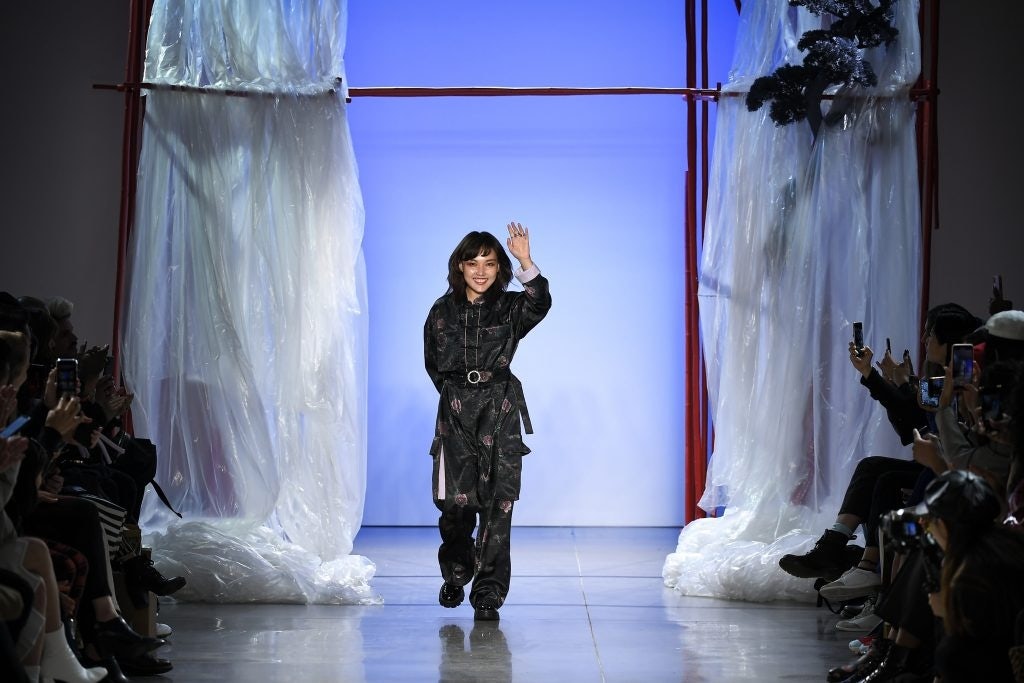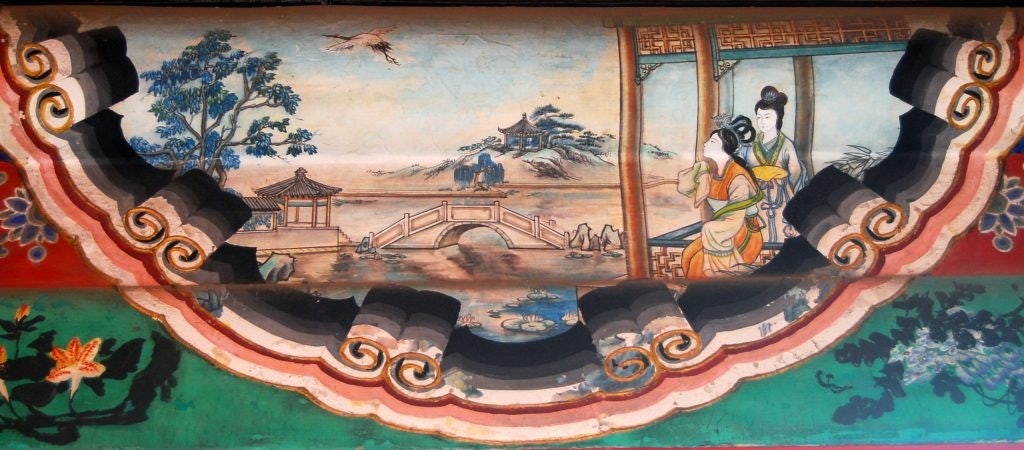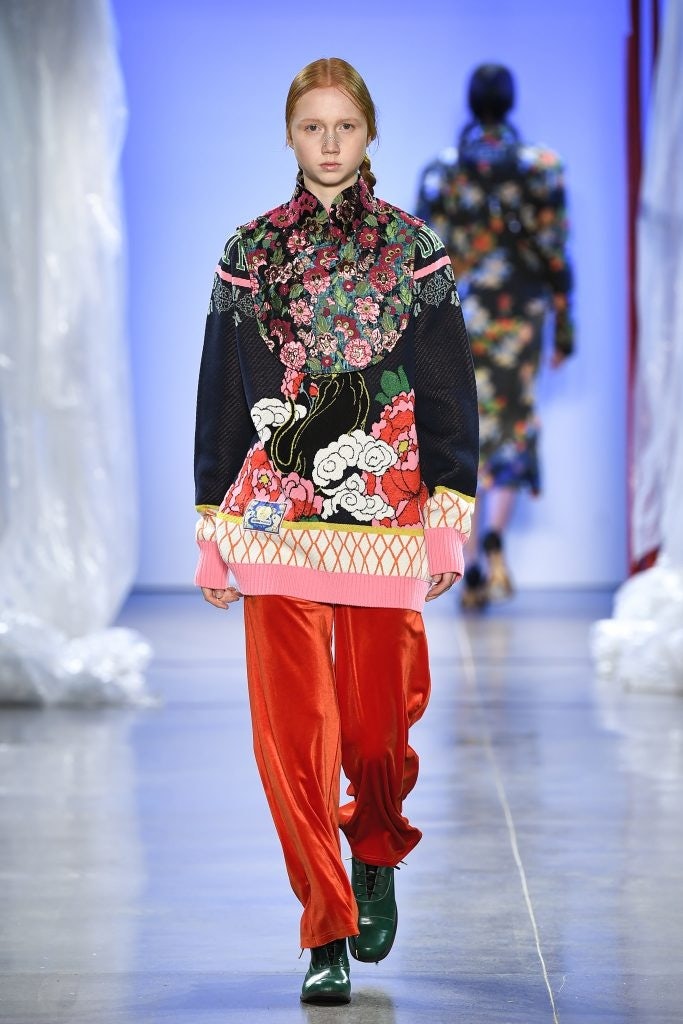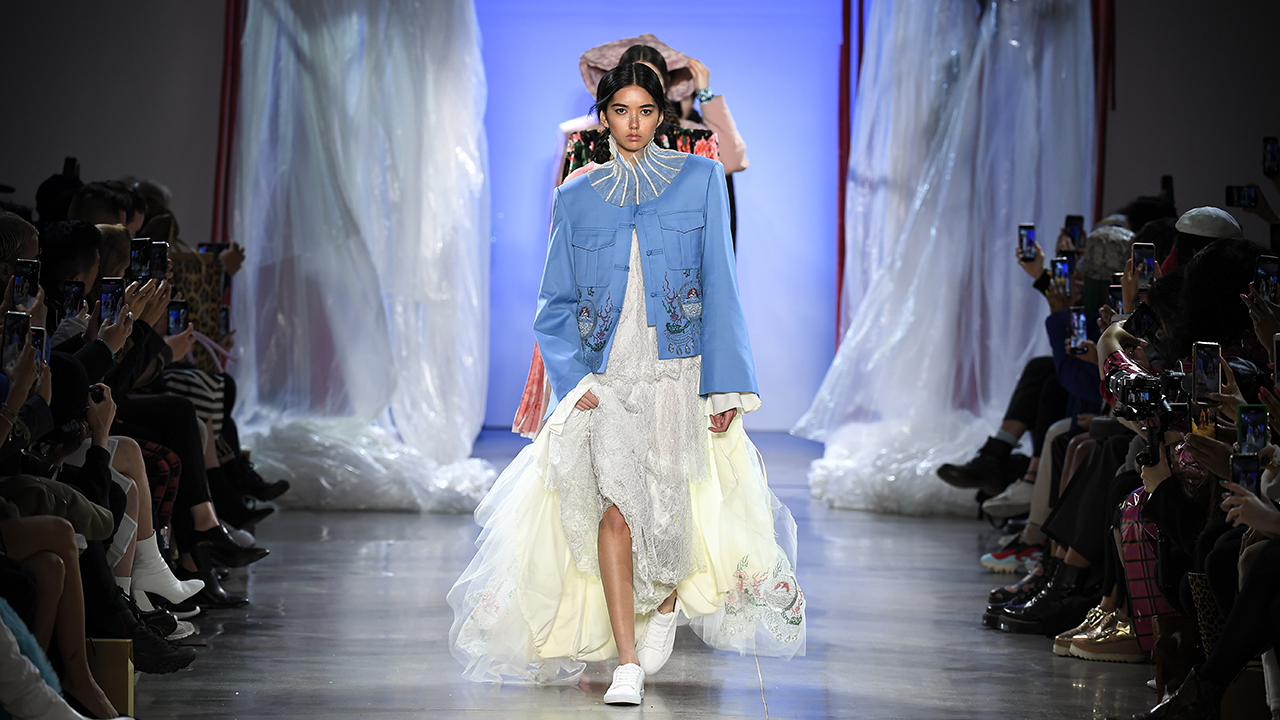The day before President Donald Trump’s coronavirus travel ban took effect, Mukzin’s team of four arrived in New York for their first runway show in the city. Short Staffed and jetlagged, Kate Han (韩雯), the co-founder and designer of Mukzin, borrowed equipment from Parsons School of Design to continue with her runway looks as production was halted in China upon the local government's order. “This is the only time when I was still sewing clothes two days before a runway, it’s pretty unforgettable,” she said.
Co-founded by Han and George Feng (冯光) in 2014, Mukzin aims to promote China’s cultural heritage and build its own design language. The two life and business partners met when studying in England. Playing to each of their strengths, Han is responsible for the creative aspects of Mukzin and Feng takes charge of the business operations. After debuting at Shanghai Fashion Week's main stage in 2017, Mukzin has also shown in Paris in 2018 and London in 2019.
This season, the coronavirus has unexpectedly set back the rise of Chinese designers, who before the crisis were gaining strong momentum on the global stage. Mukzin, among the likes of Snow Xue Gao and Claudia Li, has made it to New York. But brands such as Angel Chen and Asai have had to cancel their appearances in Milan and London, respectively.
Jing Daily met the two co-founders to talk about how they managed to navigate the impact of coronavirus for their show (which is in collaboration with China's Harbin Brewery), as well as using Chinese elements in design, the notion inclusivity, and what they look for in future business partners.

Jing Daily#
: Can we start with how you prepared for the show amid the coronavirus outbreak?#
Kate: Before we left for New York, people were asking me everyday: Can you still make it? Many Chinese brands have already cancelled their international shows by then, but I felt a mission not just to showcase our clothes but also to represent a brand from China. Although things are quite limited as to what a designer can do, we want to raise awareness on a global stage and encourage our home country to fight on. We hope that more people will understand that Chinese people, including designers like us, are trying everything to conquer the difficulties.
George: There were supposed to be eight of us to work on the runway but only four made it. People who were responsible for the runway, including the construction, didn’t make it. I stayed up until 4 a.m. the day before and only slept two hours because we were the earliest show that day.
How did you two get started in 2014? What’s the idea behind the brand?#
George: We wanted to create a brand to showcase Chinese design language, that it can be modern and fashionable. Japan has been successful on this front, and we believe that with the efforts from our generation in China, we can also build a market system that belongs to our own.
While filling the gap of this niche, we also want to promote China’s intangible cultural heritage. For example, we’ve worked with local embroiders in Xinjiang. We knew that one of the emperors in the Qing Dynasty sent around 200 embroiders to Xinjiang to teach locals about the craft. But the embroidering style has evolved and transformed to their own with the local culture, and is very abstract when compared to other styles in China. When combining with our clothes, this technique breathes life into it.

Loewe recently incorporated the straw element in their collection. But we don’t have to wait for Western brands to discover them, we can do it ourselves. We want to be original in each and every way, from fashion, design, to installation and music, all the music played at our runway shows are original.
In addition to New York, you’ve shown in Shanghai, London and Paris, what’s the main difference between them?#
George: We have different memories for each of them. For example, Paris marked our first step on the global stage, so it was very meaningful. Meanwhile, the show in London fulfilled our dream from youth. Because we spent many years living there and had seen many shows, back then we hoped to return, either to have a physical store or do a runway show. New York meant something else to us. This show isn’t just about fashion, but about China. It represented our support for the on-going crisis as young entrepreneurs.
What are your inspirations for this Fall/Winter 2020 collection?#
Kate: All of our inspirations come from clothes from ancient China, especially this season. For research, I’ve looked at an extensive amount of references from the book Dream of the Red Chamber (《红楼梦》one of China's four great classical novels), their clothes, color matching, and braids from the Ming Dynasty. At that time, young girls and boys used different ways to braid their hair, and we used that idea on our models. I incorporated many details from ancient China in my creation of clothing and turned them into something comprehensible for modern aesthetics.

We also used the idea of a hand warmer that a princess would use in the Qing Dynasty and the small accessories made of straws are also China’s intangible culture heritage. The latter were used to capture insects. Overall, I want to show the spirit of sorceress from ancient China: they are quirky and multi-ethnicity.
I saw an international crowd at the runaways, I wonder if your Chinese elements resonate well with the viewers, and also potential customers from abroad?#
Kate: We are doing pretty well in our overseas market. Local is global. I don’t think our success is owing to our representation of Chinese culture, but because we do it well. No matter where everyone’s from, you can understand aesthetics from a visual level.
If you just use a dragon or a phoenix to represent Chinese culture, I think it’s narrow-minded. I think culture is inwards and out: I grew up in China, I eat Chinese food, I see everything happening on the ground. So when I went abroad and was immersed in the Western educational system and fashion history, I grated it onto my genes and delivered what we have now, this is rather natural.
What does the brand identify with and how do you express inclusivity in your design?#
Kate: If I were to pick a time that resonates with Mukzin, it’d be Tang Dynasty because I think it was the most inclusive time in terms of politics and culture. You could see people wearing Han clothes and others wearing Hu (‘胡’, ancient nomadic people from northwestern China) clothes. Culture wise, a lot of items of music, wall painting and poems have been passed down from the dynasty. If I were to pick an age group, I think Mukzin’s clothes suit everyone from junior high students to the older generation. Style-wise, I think Mukzin can also shift easily from streetstyle to high fashion, it makes sense in both language systems.

This show is a collaboration with Harbin Brewery, can I ask what standards do you place on the brands you work with?#
George: As one of the oldest Chinese beer brands, they want to show support to Chinese designers on the global stage. A partnership only makes sense when there is a resonance. I think it’s meaningful only when they can contribute their value in the creation of a concept. I hope that brands would want to work with us not just because they want a label from a Chinese designer. We want our partner to be supportive of our culture and what we want to express. I think it’s about sharing the same vision instead of something purely commercial.
Can I ask about your vision for the brand’s future in China and abroad?#
George: We envision ourselves to be a global brand and we’re still exploring in the space runways to revenue streams. We look at how the international market sees Chinese designer brands like us and we strive to make a voice, this is how we construct our own fashion language system. I can spell out our future for certainty but we will keep moving.
